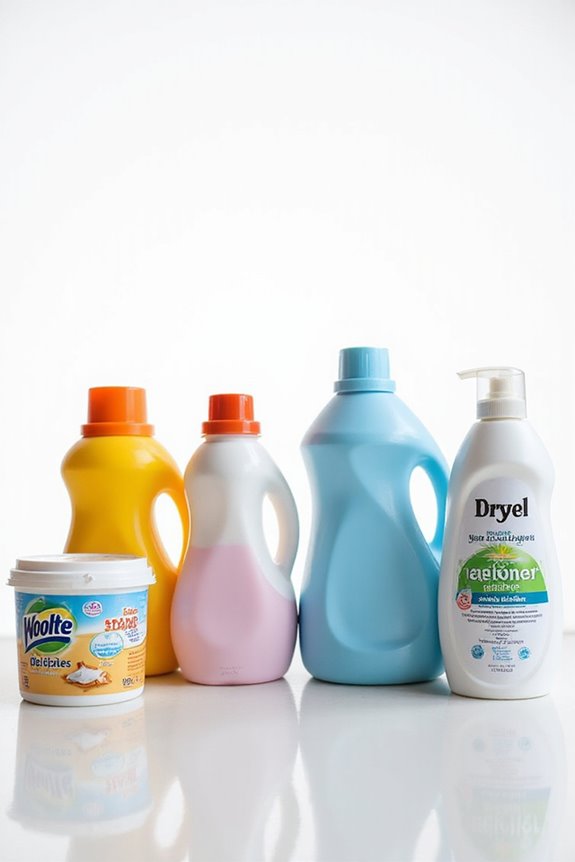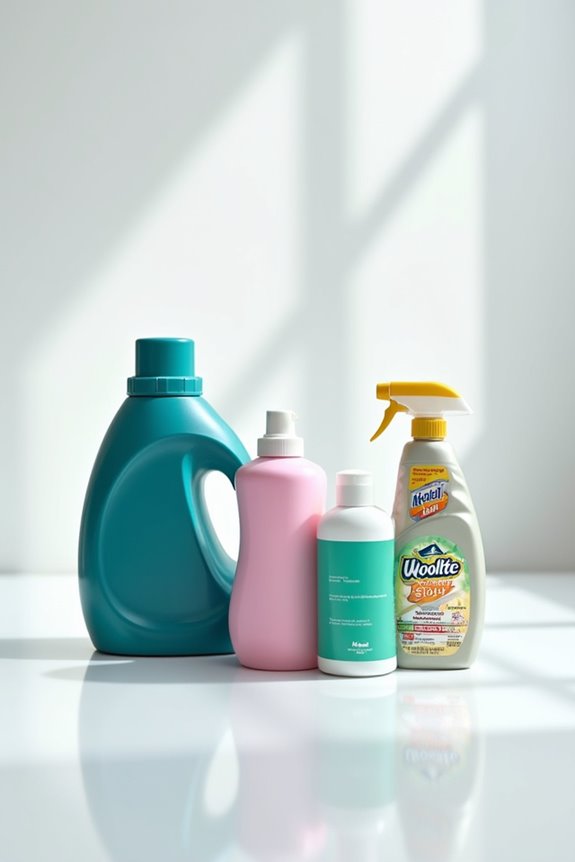When we toss a load in the washer, it’s key to measure our detergent! For a medium load, about 1/4 cup should work. If we’ve got a large load, bump it up to 1/3 cup. Don’t forget to adjust for water hardness—those in harder water areas may need a bit more. If our clothes are super dirty, doubling the amount helps too. Want to reveal more laundry secrets? Stick around for more tips!
Key Takeaways
- For a medium load (6 pounds), use the standard detergent dose indicated on the bottle; for a large load (11 pounds), increase accordingly.
- Adjust detergent based on water hardness: increase by 10-50% for moderate to hard water.
- Heavily soiled clothes may require double the standard detergent; lightly soiled items need less to prevent residue.
- Always use measuring tools like caps or shot glasses to avoid overuse, which can cause fabric damage and machine issues.
- Proper storage and consistent laundry routines can enhance detergent effectiveness and minimize waste.
Understanding Load Sizes and Detergent Needs
When we think about doing laundry, one of the first things we should consider is the load size. Understanding the load capacity of our washing machine is essential. For instance, a medium load weighs about 6 pounds, while a large load is around 11 pounds. Knowing these weights helps us avoid overloading, which can prevent our clothes from tumbling freely. Different fabric types, too, can impact how we measure our loads. For example, heavier fabrics might take up more space, while lighter ones can allow us to fit more in. By estimating our loads accurately, we optimize cleaning efficiency and save on water and energy. Additionally, using the right amount of detergent per load is crucial for effective cleaning without wasting product. So, let’s keep those load sizes in mind next time we tackle laundry day!
The Importance of Measuring Detergent
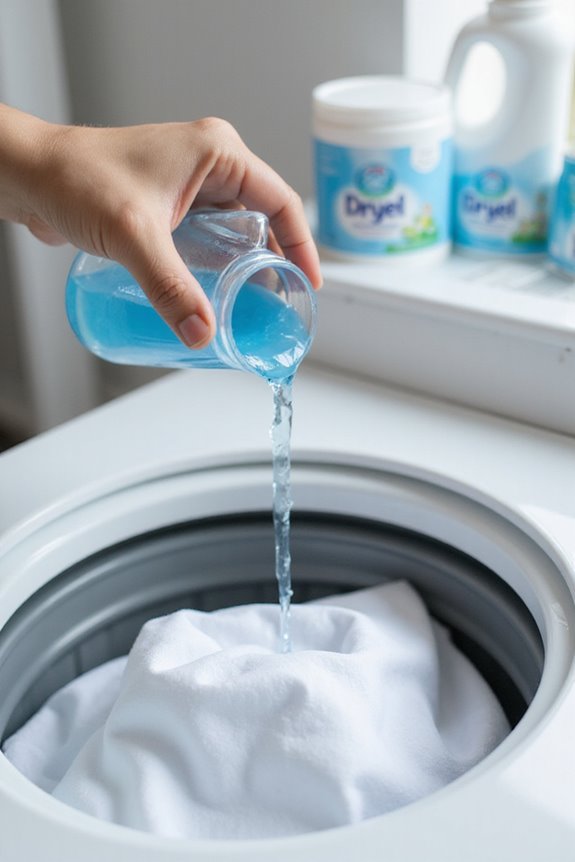
Measuring detergent might seem like a small detail, but it can make a big difference in our laundry routine. When we get our detergent measurement right, we guarantee our clothes come out clean without any annoying residues or skin irritations. If we use too much, we risk damaging our fabrics and washing machines. Underusing detergent? Well, that can leave our clothes looking dingy and smelling less than fresh. Plus, being mindful of how much we use helps the environment by reducing water pollution and energy consumption. It’s all about consumer awareness. So, let’s embrace accurate dosing—our wallets, our clothes, and the planet will thank us. After all, nobody wants a laundry disaster, right? Choosing the right detergent with effective odor-fighting ingredients can further enhance the freshness of our laundry.
Adjusting for Water Hardness
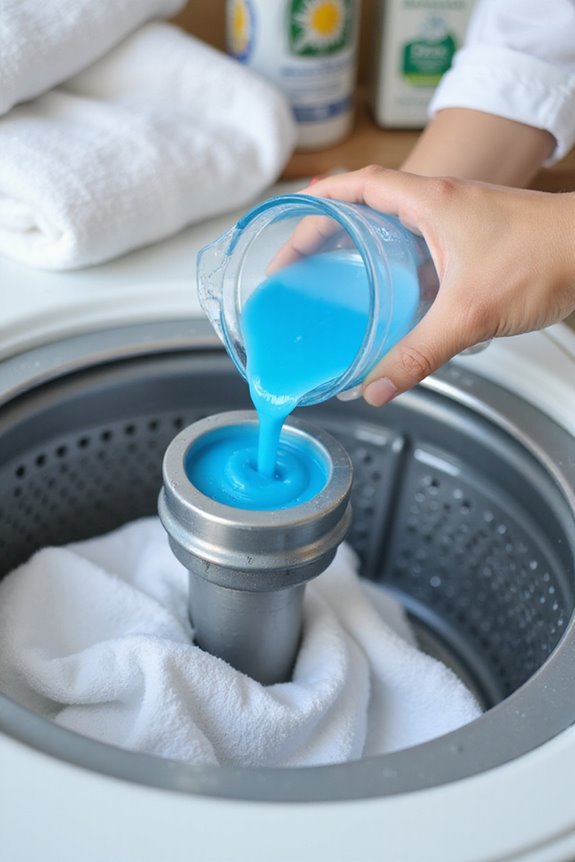
Adjusting our laundry detergent for water hardness is essential for getting the best clean possible. If we live in a soft water area, we can stick to the standard detergent dose. However, for moderate hardness, we might need to increase our detergent by 10-20%. In hard water zones, a 30-50% boost is often necessary. Remember, those pesky minerals like calcium and magnesium can mess with our detergent’s performance.
Using detergents formulated for hard water can help us avoid overdoing it. Some detergent types even have built-in water softeners. We should also consider adding a laundry booster if needed. By fine-tuning our detergent based on water hardness, we can keep our clothes fresh and our washing machines happy!
Effects of Soil Level on Detergent Usage

Soil level plays an essential role in how much laundry detergent we should use, and understanding this can save us from frustrating laundry mishaps. When we deal with heavily soiled clothes, like those covered in mud or grease, we need to double our detergent compared to normal loads. On the flip side, lightly soiled items require less detergent to avoid that pesky residue. It’s all about balance! We’ve learned that different soil types can affect our choices too. For stubborn stains, a stain pretreatment can help before we toss everything in. Remember, using a measuring cup or even a shot glass makes it easier to adjust our detergent based on how dirty our clothes really are. Additionally, using a hard water-specific detergent can significantly improve cleaning effectiveness in areas with high mineral content. Happy washing!
Detergent Dosage for High Efficiency Machines
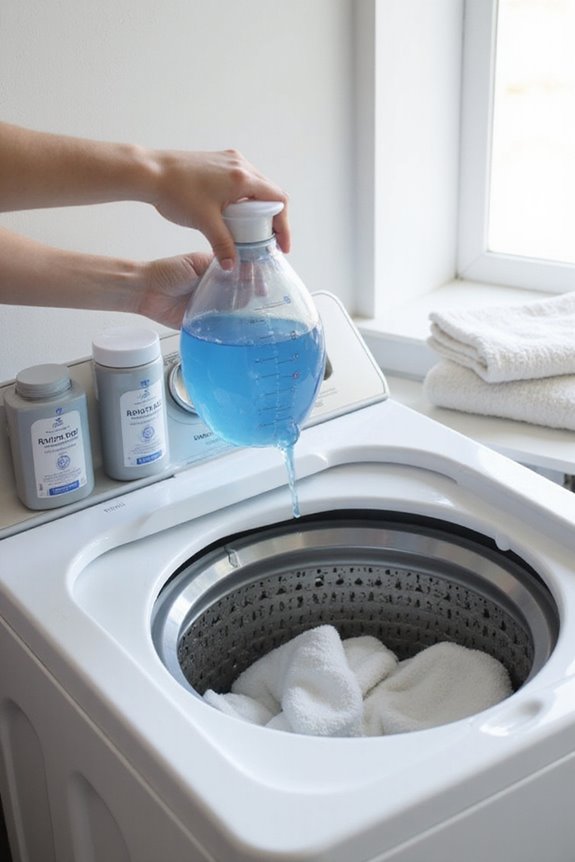
Have you ever wondered how much detergent to actually use in our high-efficiency (HE) machines? It turns out, we need much less than with standard washers! For small loads, just a teaspoon of HE detergent will do. Medium loads need about 2 teaspoons, while large loads only require 2-3 teaspoons. Since HE detergents are highly concentrated, they pack a powerful punch, meaning we can use less. Plus, many of our machines have automated dispensers that adjust based on load size and detergent concentration. So, if we’re using a more concentrated detergent, we might only need about half an ounce! Let’s embrace these machines to save detergent and help the planet—all while keeping our clothes clean! Additionally, using high-efficiency (HE) detergents is essential to avoid detergent buildup in front-loading washers.
Risks Associated With Overusing Detergent
When it comes to laundry, we often think more is better, but that’s not always the case with detergent. Overusing detergent can lead to skin sensitivity, leaving us with irritating rashes and uncomfortable dryness. Our clothes may feel stiff and smell funny due to a build-up of residue. Plus, too much detergent can cause washing machine damage, clogging hoses and promoting mold growth. It’s not just our machines that suffer—there’s economic waste too! Using more detergent than needed can hit our wallets hard and even contribute to environmental pollution. Those extra chemicals can harm aquatic life when they enter water systems. Additionally, many detergents contain harsh chemicals that can exacerbate skin irritation, making it essential to use the recommended amount. So, let’s remember: less can really be more when it comes to laundry detergent!
Best Practices for Detergent Application
To make laundry day a breeze, we should focus on applying detergent correctly. First, let’s check the detergent storage to verify it’s in a cool, dry place. Next, using measuring tools like shot glasses can help us avoid the dreaded “eyeballing” method. For a normal load, we typically need about 1½ ounces, or three tablespoons, of detergent. If our load is medium-sized, just two tablespoons will do. It’s essential to follow product guidelines and not rely solely on the washer’s dispenser indicator. Remember, heavier soiling calls for a bit more detergent! By measuring precisely, we’ll keep our clothes clean and our washing machines happy. Additionally, using concentrated laundry detergents can enhance cleaning efficiency while reducing the amount needed per load. Who knew laundry could be so scientific?
Differences Between Conventional and HE Machines
While we might think that all washing machines are created equal, the truth is, there are significant differences between conventional and high-efficiency (HE) machines. HE machines use less water and require specially formulated detergents to work effectively. These HE detergents are highly concentrated and create low suds, which is perfect for their low-water environment. In contrast, conventional detergents produce excessive suds and can lead to mechanical issues if used in HE machines. So, when it comes to washing machine compatibility, using the right detergent formulation is key. We’ve learned the hard way—using regular detergent in an HE washer can turn laundry day into a foamy disaster. Stick to HE detergents for your HE machines; trust us, your laundry will thank you!
Environmental Impact of Excess Detergent
Excess detergent might seem harmless at first, but it can seriously mess with our environment. When we use too much, we contribute to chemical pollution, harming aquatic ecosystems. High detergent dosages lead to algal blooms that suffocate fish and other aquatic life. Plus, overusing powder detergents can increase microfiber shedding, further polluting our waterways. And let’s not forget about plastic waste; those heavy-duty detergent bottles pile up in landfills and oceans every year. We’ve all seen those sad images of sea turtles mistaking plastic for food. By using just the right amount of detergent, we can help reduce our carbon footprint while keeping our planet a little cleaner. Let’s wash responsibly!
Tips for Consistent Detergent Dosing
Getting the right amount of laundry detergent can feel a bit tricky sometimes, but it doesn’t have to be. To guarantee consistent dosing, we should always use measuring tools, like the cap that comes with our detergent or even a shot glass. This way, we avoid the guesswork that can lead to overdosing.
Let’s follow the manufacturer’s dosage guidelines, adjusting for load size and soil level. For heavier loads, we need more detergent, while smaller loads require less. If our water is hard, we might need a bit more detergent, too. By keeping our detergent stored properly and sticking to a routine, we can make laundry day smoother and more effective. Plus, no one likes soap residue on their favorite shirt!
Frequently Asked Questions
Can I Mix Different Brands of Detergent in One Load?
We shouldn’t mix different brands of detergent in one load. Brand compatibility is essential; mixing can reduce detergent effectiveness, dilute active ingredients, and lead to inconsistent wash results. Let’s stick to one brand for better outcomes.
How Do I Know if My Detergent Is He-Compatible?
To know if our detergent’s HE-compatible, we should look for the HE symbol or specific phrases on the label. Choosing recognized HE detergent brands guarantees we reap all the HE detergent benefits for efficient washing.
What’S the Best Way to Store Laundry Detergent?
Imagine a laundry sanctuary; we should store our detergent wisely. Airtight containers preserve powdered forms, while sealed bottles protect liquids. Let’s organize shelves with labeled bins, ensuring our detergent storage is both practical and visually appealing.
Does Using More Detergent Improve Stain Removal?
We’ve learned that using more detergent doesn’t necessarily improve stain removal; in fact, it can hinder detergent effectiveness. Proper dosing guarantees ideal cleaning without residue, maximizing our laundry results while protecting our clothes and appliances.
Can I Use Detergent Pods in Any Washing Machine Type?
Pod compatibility’s pretty perfect! We can use detergent pods in various washing machines, from top-loaders to front-loaders. Just remember, different detergent types may require specific practices, so check your machine’s manual for best results.

